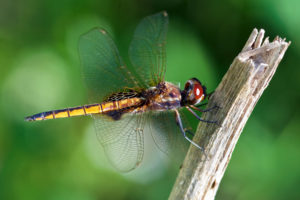After six years on my study site, aka my yard, I thought I’d about exhausted the possibilities of new species. But it turns out I was wrong. A new dragonfly species showed up near the end of November: Hyacinth Glider (Miathyria marcella).

This is a small dragonfly, much smaller than the other “gliders” (usually called Saddlebags for the characteristic markings on their wings), Carolina, Red, and Black. According to Odonata Central, this species wasn’t recorded in the United States until 1950 (although Dunkle [1989] dates a record of it in Florida in 1934), and its range is pretty much limited by the cold tolerance of its larval host plant, water hyacinth (Eichhornia crassipes), which was itself introduced into the United States in 1884. (Sadly, although not much is available online about their life cycle, it appears that the dragonfly larvae aren’t an effective means of limiting the spread of this particularly noxious invasive species, as its habitat is the hanging roots of this invasive aquatic plant.)
According to the UF/IFAS website about water hyacinth, the plant has some characteristics that are either amazing (if you’re looking for its use in a pond or fountain) or terrifying (if you’re concerned about clogging rivers and canals in ecosystems that aren’t equipped to handle it):
- Water hyacinth grows faster than any other tested plant . . . ; populations can double in as little as 6 days
- Water hyacinth reproduces vegetatively and sexually; new rosettes (daughter plants) are formed on floating stolons which grow from the mother plants
For a particularly interesting story of its introduction and spread in Florida, read the fact sheet here. A few interesting tidbits:
Dense floating mats can form an “island” that supports populations of grasses, herbaceous plants and small trees, which can further strengthen the floating mat. Large waterhyacinth colonies greatly reduce water flow, which can interfere with irrigation and flood control efforts, and they can make boating, fishing, and swimming impossible. Also, dense populations block light penetration through the water column, which greatly reduces or prevents oxygen production by shading
out submersed plants and phytoplankton, thus reducing oxygen concentrations to levels that are dangerous for fish and other aquatic wildlife.
Etymology
Miathyria means “my windows”; this might refer to the relatively large “cells” in the pattern of the wings of dragonflies in this genus. Marcella, of course, means “little warrior,” although Paulson and Dunkle, in their Annotated Checklist of North American Odonata prefer to think of it as referring to “an unknown woman” for some reason.
References
Dunkle, S.W. 1989. Dragonflies of the Florida Peninsula, Bermuda and the Bahamas. Scientific Publishers, Gainesville, Florida
Paulson, D. R., and S. W. Dunkle. 2016. A Checklist of North American Odonata
Including English Name, Etymology, Type Locality, and Distribution. PDF.
